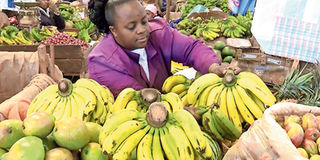Technology can help farmers reduce losses

Lillian Njuguna arranges fruits for sale in her stall at the Nyeri open air market in Nyeri town. Farmers can source and secure a market well in advance before produce is ready for sale, thereby negotiating for a good price. PHOTO | FILE| NMG
What you need to know:
Farmers and consumers need to be part of this digital revolution because they are key players in minimising food wastage.
The optimistic perspective is that there are plans to lessen these losses to 15 per cent by 2022 as part of the government’s Big Four Agenda.
Therefore, scientific methods of determining post-harvest loss will make it easier for authorities to take sanguine action with key deliverables in mind.
Every year, farmers lose a third of their produce through post-harvest losses, while consumers waste food by buying more than they need.
Post-harvest losses negate farmers’ efforts to get their crops ready for the market. The fundamental factors that lead to this situation include poor management, storage, and conveyance of the crop from the farm to the market.
LOW PRICES
As much as food spoilage is a global problem, it’s most prevalent in Africa due to poor physical infrastructure as well as technological mishaps. Lack of proper facilities after harvesting means that 40 per cent of food is wasted before consumption.
Farmers and consumers have been taken hostage by middlemen because dissemination of information is controlled by a few players in the agricultural value chain. This is estimated to cost the Kenyan economy Sh150 billion, which calls for a multi-sectoral approach to counter.
Although infrastructural developments such as good road networks will ensure farm produce reaches the market on time, it needs a huge capital outlay. In this regard, we cannot but underscore the importance of technology in bridging agricultural food distribution gaps because it has a latent potential of bringing on board all the players seamlessly and cost-effectively. Notably, it will help in marketing and avoiding intermediaries who buy farmers’ produce at low prices, yet it spoils en route to the market or while at the market.
The rationale for embracing technology in agriculture is to ensure farmers find markets within and without the known localities. For example, a carrot farmer from Londiani does not necessarily have to rely on a middleman to inspect his carrot crop and propose a day for harvesting if all he needs is to sign up to a mobile application to sell his crop.
SOURCE MARKETS
For a sustainable agricultural ecosystem, players should be encouraged to develop platforms that provide a market place for both buyers and sellers, which will infuse e-commerce in the food supply chain. This can be achieved because Kenya’s mobile penetration has hit 100 per cent, according to data released by the Communications Authority of Kenya for the quarter ending September 2018. The critical perspective is that vendors will only procure the produce that they need, which will annihilate all the losses that farmers make perennially.
With technological advancements, farmers can enhance their bargaining power through mobile money payments because they will not have to worry about their produce going to waste, forcing them to sell at throwaway prices. They can source and secure a market well in advance before produce is ready for sale, thereby negotiating for a good price that will sustainably enable them to grow subsequent crops and improve their livelihoods.
Farmers and consumers need to be part of this digital revolution because they are key players in minimising food wastage. The optimistic perspective is that there are plans to lessen these losses to 15 per cent by 2022 as part of the government’s Big Four Agenda. Therefore, scientific methods of determining post-harvest loss will make it easier for authorities to take sanguine action with key deliverables in mind.
Nickson Onyango is an agricultural economist. [email protected]




